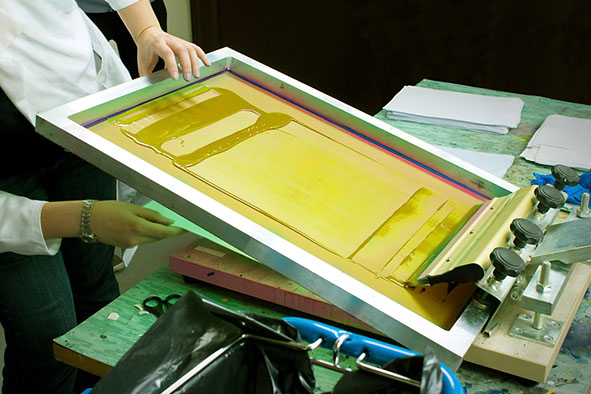Blog
Promotional Merchandise Industry Jargon Explained

Screen printing in action
The sheer range of promotional products that can be branded with a logo or message is vast.
Dependent on the type of product it’ll either be manufactured to order or a Chinese imported product that’s stocked in Europe and then overprinted to order.
The material a product is made from, the artwork and the date the goods are required will determine the lead time and the most suitable personalisation method.
Below we shed some light on promotional merchandise industry terminology you might find amid all the quotation paperwork.
Lead Time
Time from placing an order to delivery. Whether a product is custom-made or an overprinted stock item will affect lead time. Generally, standard overprinted stock can be supplied from three days to two weeks. Made to order will take anything from 3-14 weeks subject to country of manufacture, shipping method and type of product.
Maximum Print Area
The area on which branding can be applied. An overprinted product’s maximum print area is dictated by the equipment used. Bespoke manufactured items will tend to have a bigger print area.
Artwork
EPS vectorised artwork is an industry standard although Photoshop layered files for litho print and high resolution jpegs can be used for digital printing.
Pantone Colours
A standardised colour matching system used by designers and manufacturers.
Personalisation Method
The method used to brand a product.
Laser Engraving
Whereby a laser burns the design into the surface of the material. Mostly for metal but also suitable on wood, real and imitation leather, plastic, slate and cork.
Embossing
A die of the artwork creates an indented impression in the product’s surface. Foil can be inserted between the die and material to create gold or silver embossing. Leather products such as conference folders and memo books are usually embossed.
Screen Print
Ink is transferred through a screen mesh using a squeegee. Clothing / textiles and an array of plastic products are best suited to this method.
Embroidery
Logos are recreated in material with specialist machinery. Thread colours are not an exact Pantone match but pretty close. It’s best not to recreate shades and blends of colours; where possible stick to using solid colours. Best suited to clothing, caps and bags.
Transfer Print
Enables CMYK printing – a four colour process: cyan (blue), magenta (red), yellow and black. The logo is printed directly onto transfer paper rather than the product. The paper is pressed onto the product with a heat press. Once cool the transfer paper is removed, leaving the printed image bonded to the item. Suitable on smaller runs for t-shirts, bags and stress balls.
Dye Sublimation Printing
Similar to transfer printing, with a full-colour design printed on special paper, but in this case inks are applied via a heat press. The inks convert to a gaseous state, enabling them to penetrate the surface to form a permanent image. Long-lasting and resistant to scratching unlike some other printing methods that merely print onto the surface.
Digital Print
The main difference between digital printing and traditional methods like screen or pad printing is that there’s no need to produce or replace screens or plates. Most digital systems contain four colours.
Origination
Often you’ll find an origination charge on a quotation. This is for printing frames & machinery tools that need to be manufactured in order to personlise a product. Sometimes a one-off payment is charged for each colour printed subject to the process. If your order is repeated it may be shown on additional orders as a repeat origination charge.
Screen Origination
Usually a monofilament polyester screen mesh that’s stretched over an aluminium or wooden frame. A frame will be needed for each colour printed. Originally silk was used to make the screen mesh hence the term ‘silk screen printing’.
Arcadia has been supplying promotional products to some of the world’s largest brands for over 17 years. We have specialist knowledge of manufacturing and print processes and offer consultative advise from initial brief to delivery of goods.
Make Memorable Merchandise
[mailmunch-form id=”172197″]
Having worked in Promotional Merchandise for the last 25 years I have been exposed to all aspects of the industry. Starting out as an account manager working with some of the worlds leading brands, I have learnt to understand the needs of a client, manufacturing processes, and what it takes to deliver a successful promotional campaign that is on brand, on time and within a given budget.
